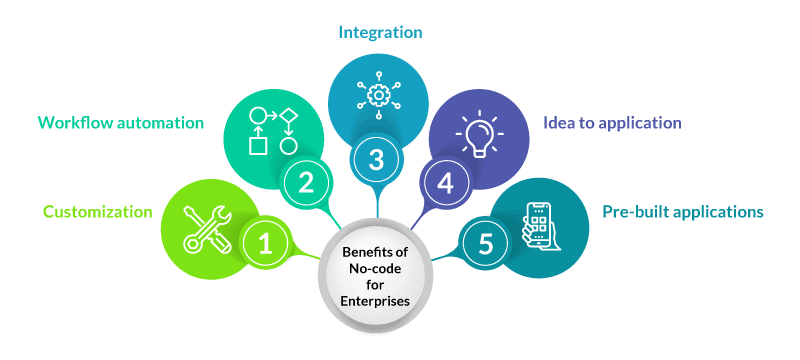
Digital transformation has become the need of the hour so what if we told you that there is a software that could aid every level of an organization whether small, medium, or large; would you avail of it? No-code for enterprise aids every level just like frosting between each layer of a cake makes it better.
Coding has changed in the past decade considerably; the need for professional development has reduced and the amount of citizen developers have grown exponentially.
To learn more about no-code for enterprise at different levels, do continue reading this blog post.
Understanding coding
The concept of coding was first extremely complex as it involved designing a syntax for machines to comprehend and implement for the better working of humans. This was restricted to people who had developed this skill over lots of practice i.e. professional developers.
Machine coding was so complicated with its binary codes (0s and 1s) that it is very rare to have programmers that memorize every numerical code and modification. The complexity of coding was simplified by computer engineers slowly and steadily over time and thus, bridging the gap between human language and machine language.
The game of software development continued to change and ultimately led to the emergence of no-code; which essentially changed the game altogether.
But let’s talk about how programming evolved and what’s best for each enterprise level before we get to that, shall we?
After machine learning comes low level programming, high level programming, low-code, and then ultimately, no-code.
1. Low-level programming languages
These assembly languages provide the first and base level of abstraction of code. It uses alphanumeric mnemonic codes rather than binary codes.
2. High-level programming languages
a) First generation (Late 1950’s)
Languages like FORTRAN and COBOL used compilers to translate more natural elements back into machine codes and this was when people showed academic interest in learning how to code.
b) Second generation
Repeatable first generation languages were automated by developers; this not only simplified but also sped up the coding process. Languages like C++ were used to streamline the process of coding further.
3. Low-code
While high-level programming languages are definitely a jump ahead of machine code and low-level languages, there is still a lot of time consumption if looked at as a mechanism for developers.
Low-code platforms have recent times come up to facilitate and further automate development, offering a visual configuration interface that churns out users’ programming languages.
From there, where appropriate, engineers edit and enhance the resulting codebase.
Also Read: Enterprise Digital Transformation: Seamlessly Bridging the Gap
4. No-code
What is no-code? It, as the name so very blatantly implies, is the use of absolutely no coding and still achieving the same results that coding achieves. This revolutionary mechanism redefined the meaning of a professional coder.
With the help of no-code, anybody could become a coder. No professional knowledge was necessary anymore. This came to be known as Citizen Development.
Also read: Citizen Developer vs. Professional Developer
The code is so simplified that it is adapted into a drag and drop visual interface wherein the ready-to-use components are used for application building just like lego game. Yes, it’s that simple.
It’s fast, it’s cost-effective and allows people running businesses to meet the dynamic and quick demands of their customers. Investing in it not only makes you but everybody in your organization a programmer.
No-code Solution for enterprises
For existing enterprises and their smooth functioning through enterprise applications too, no-code can be extremely useful. So, what are enterprise apps?
They are defined applications used by organizations to run the fundamental functions of the business. A large system is created in the enterprise with these enterprise apps integrating with one another.
An app becomes enterprise level when it fulfils the following criteria:
- serves organizations with hundreds to thousands of employees
- provide comprehensive, scalable and secure solutions
Gartner predicts that by 2025, three out of four large enterprises will be using a minimum of four no-code, low-code development tools to support IT application development and citizen development initiatives.
By 2025, three out of four large enterprises will be using a minimum of four no-code low-code development tools to support IT application development and citizen development initiatives
Gartner
No-code for small enterprises
For small enterprises, no-code can serve to create a foundation for the rest of the organization to rely on. It can be highly beneficial in the following ways:
1. Faster time-to-market
Larger organizations may have a more flexible timetable for new products to be created, but smaller enterprises need more mobility and faster turnaround times. The most non-technical of founders can experiment with speedy prototyping using no-code and can create solutions in a couple of hours.
2. Saving and effectiveness of cost
There is no cost of hiring full-time professional developers, even the overhead costs of the same are saved. This is accompanied by building an application by yourself in a much lesser time. And time is money so this translates into saving costs as well.
3. High level of flexibility
With conventional coding, it is typically difficult for developers to rapidly modify a function or a feature, and it can take a considerable amount of time to make even a minor tweak.
A no-code creation framework, on the other hand, is much more versatile and a new logic is all you need. In as little as a few hours, the change can then be implemented.
Also Read: Break Down Data Silos: The Power of Enterprise Application Integration
4. Workflow automation enables you to focus on your business
Repetitive business tasks can be automated and the time saved in that can be used to actually focus on the growth of your business. This facilitates the growth and development of smaller enterprises and creates a feasible path for its future.
Small enterprises can also build their ERPs inside out using no-code. This can be done phased through automation of department processes, one at a time.
Read more: Next Generation ERP System with Low-Code No-Code
No-code for large enterprises
No-code is definitely helpful for small enterprises for a number of reasons including cost-effectiveness, flexibility, quicker moves into the market, etc.
When it comes to large enterprises, there are already systems in place that hold the ground for the organization’s functioning. However, the role of no-code here is filling in the various gaps in this system by integrating enterprise applications with one another.

No-code low-code platforms allow and encourage organizations to meet the demand for new enterprise solutions without:
- overburdening IT
- depleting capital
- filling expensive talent deficiencies
These are three major obstacles to the acquisition and development of enterprise applications.
With no-code, enterprises can modernize their legacy software that is otherwise difficult to customize and maintain, hard to extend, pose security threats, and are not always compatible with the latest products and technology. As per Harris Poll, companies today lose upward of $300 billion a year paying down “technical debt,” as developers pour time into maintaining legacy systems or dealing with the ramifications of bad and old legacy software.
Also read: Digital Modernization a Must. Modernize your Enterprise IT today!
Using no-code for enterprises also gives it the advantage of speed and agility. The Principal Analyst and VP of Forrester, John Rymer has mentioned that no-code low-code can speed up the development of software by 10-times than by the general method of writing code.
No-code low-code can speed up the development of software by 10-times than by the general method of writing code.
John Rymer, principal analyst, forrester
Advanced no-code platforms like Quixy provides all the necessary features and controls to meet enterprise requirements. These include:
- Hosting on private cloud
- Roles and permissions
- Audit trail
- IP filtering
- SSO
- Custom password policies
- Two-step authentication
- White labeling
- Offline billing
Also Read: Why Choose Quixy as Your No-Code Application Development Platform?
No-code for medium enterprises
Now that you understand how no-code can be used in small and large enterprises, look at how it aids in medium level enterprises as well.
While the smaller enterprises are given the aid to build from the ground up and the large enterprises have their gaps filled with no code, medium enterprises are in the stage between the small and large levels.
At this level, no-code helps create prototypes of applications much faster than professional development can. The development of the enterprise into a large organization in the competitive market is only possible if medium enterprises are given the scope to grow.
No-code platforms
Many platforms can aid the furthering of your processes efficiently and effectively. No-code for enterprises at every level is just part of what this revolutionary technology can achieve.
Here are some no-code platforms that can be helpful for your business.
- Webflow can help you create a CMS-driven site
- Shopify can help you create an e-commerce shop
- Quixy can help you automate processes and build enterprise-grade applications
- Thunkable can help you create a mobile application
- Substack can help you create a paid newsletter
- Readymag can help you host an online magazine
- Sheet2Site can help you turn a google sheet into a website
Also Read: Top 10 No-Code Startups Disrupting Industries
Why should you use no-code for enterprises?
There are a whole lot of benefits of no-code for enterprises in any industry. As mentioned and explained above, solutions can be provided at every level of an enterprise.
The question should be, why NOT use no-code for enterprises? Lets take a look at all the benefits and uses of no-code:

1. Customization
You can build applications just the way you want them. Your vision can be actualised without the dependency on a professional developer who may not completely or clearly understand it.
2. Workflow automation
Enable your enterprise to automate its workflows with ease. Allow more time and money to be saved for your employees and your enterprise as a whole.
3. Integration
Facilitate integration of applications – existing or new – in your enterprise. No-code helps build new systems and/or fill gaps in existing systems.
4. Idea to application
There is no in-between with no-code, if you have the idea in mind, you can make the application. Regardless of the role you play in the organization, you have the ability to build an application.
5. Enjoy a suite of pre-built applications
Many no-code platforms such as Quixy, Zoho, Kissflow etc. have a suite of pre-built applications for enterprises to use and avail the facilities of.
Also read: Savings with Quixy: This Customer saved $8000 a month in enterprise software!
The Future
Ultimately, no-code for enterprises has really changed the game by facilitating the development and forward-thinking, and actualization of businesses all over the world. It truly has become the future of work.
Quixy is a no-code development platform that can enable anybody to build applications in a short time span. The benefits of technology for businesses can be magnified by using no-code for enterprises.
Begin your journey towards streamlined operations and tailored apps – all with the simplicity of our platform. Get started today to harness the potential of automation.
Frequently Asked Questions (FAQs)
Q. What is no-code low-code enterprise?
No-code and low-code enterprise platforms enable the development of software applications with minimal coding. No-code platforms provide visual interfaces and pre-built components for non-technical users to create applications through drag-and-drop and declarative methods. Low-code platforms offer similar features but also allow customization through code snippets and integrations. Both approaches empower users to build applications without extensive programming knowledge, reducing development time and costs. These platforms find applications in areas like process automation, workflow management, CRM, and CMS, providing a faster and more accessible way to create software solutions for businesses.
Q. Can enterprise benefit from No-Code?
No-code benefits enterprises through faster application development, cost savings, empowering non-technical users, customization flexibility, improved collaboration, and scalability. It enables rapid response to market needs, reduces development expenses, allows employees to create solutions, tailors applications to specific requirements, enhances cross-functional collaboration, and handles infrastructure maintenance. Ultimately, no-code empowers enterprises to deliver applications quickly, drive innovation, and achieve business growth.
Q. How does no-code benefit enterprise-level organizations?
No-code offers numerous benefits for enterprises, including faster application development, cost savings, empowering business users, customization flexibility, improved collaboration, and scalability. It enables enterprises to deliver applications quickly, drive innovation, and achieve business growth.
Q. Is no-code development secure for enterprise applications?
No-code platforms prioritize security and offer built-in measures to ensure application security. These platforms follow industry-standard security practices, provide user access controls, and offer data encryption options, making them suitable for enterprise-level applications.
Q. Can no-code platforms integrate with existing enterprise systems and databases?
Yes, most no-code platforms offer integration capabilities through connectors, APIs, or built-in integrations. This allows seamless integration with existing enterprise systems, databases, and data sources, ensuring a unified and efficient workflow.
Subscribe
Login
Please login to comment
0 Comments
Oldest















